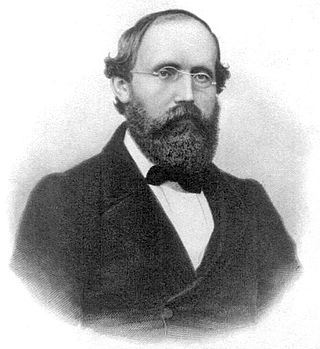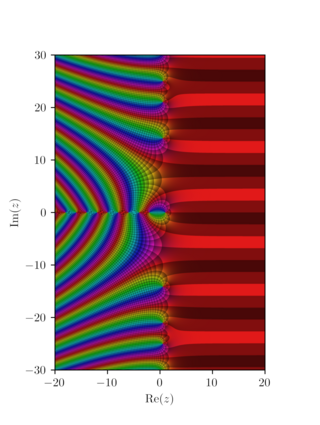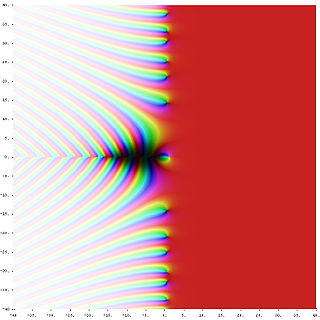Related Research Articles

Algebraic geometry is a branch of mathematics which classically studies zeros of multivariate polynomials. Modern algebraic geometry is based on the use of abstract algebraic techniques, mainly from commutative algebra, for solving geometrical problems about these sets of zeros.

Georg Friedrich Bernhard Riemann was a German mathematician who made profound contributions to analysis, number theory, and differential geometry. In the field of real analysis, he is mostly known for the first rigorous formulation of the integral, the Riemann integral, and his work on Fourier series. His contributions to complex analysis include most notably the introduction of Riemann surfaces, breaking new ground in a natural, geometric treatment of complex analysis. His 1859 paper on the prime-counting function, containing the original statement of the Riemann hypothesis, is regarded as a foundational paper of analytic number theory. Through his pioneering contributions to differential geometry, Riemann laid the foundations of the mathematics of general relativity. He is considered by many to be one of the greatest mathematicians of all time.

In mathematics, particularly in complex analysis, a Riemann surface is a connected one-dimensional complex manifold. These surfaces were first studied by and are named after Bernhard Riemann. Riemann surfaces can be thought of as deformed versions of the complex plane: locally near every point they look like patches of the complex plane, but the global topology can be quite different. For example, they can look like a sphere or a torus or several sheets glued together.

In mathematics, complex geometry is the study of geometric structures and constructions arising out of, or described by, the complex numbers. In particular, complex geometry is concerned with the study of spaces such as complex manifolds and complex algebraic varieties, functions of several complex variables, and holomorphic constructions such as holomorphic vector bundles and coherent sheaves. Application of transcendental methods to algebraic geometry falls in this category, together with more geometric aspects of complex analysis.

In mathematics, an L-function is a meromorphic function on the complex plane, associated to one out of several categories of mathematical objects. An L-series is a Dirichlet series, usually convergent on a half-plane, that may give rise to an L-function via analytic continuation. The Riemann zeta function is an example of an L-function, and one important conjecture involving L-functions is the Riemann hypothesis and its generalization.

In mathematics, analytic number theory is a branch of number theory that uses methods from mathematical analysis to solve problems about the integers. It is often said to have begun with Peter Gustav Lejeune Dirichlet's 1837 introduction of Dirichlet L-functions to give the first proof of Dirichlet's theorem on arithmetic progressions. It is well known for its results on prime numbers and additive number theory.
In mathematics, the uniformization theorem says that every simply connected Riemann surface is conformally equivalent to one of three Riemann surfaces: the open unit disk, the complex plane, or the Riemann sphere. The theorem is a generalization of the Riemann mapping theorem from simply connected open subsets of the plane to arbitrary simply connected Riemann surfaces.
The theory of functions of several complex variables is the branch of mathematics dealing with functions defined on the complex coordinate space , that is, n-tuples of complex numbers. The name of the field dealing with the properties of these functions is called several complex variables, which the Mathematics Subject Classification has as a top-level heading.
In harmonic analysis and number theory, an automorphic form is a well-behaved function from a topological group G to the complex numbers which is invariant under the action of a discrete subgroup of the topological group. Automorphic forms are a generalization of the idea of periodic functions in Euclidean space to general topological groups.
The twenty-first problem of the 23 Hilbert problems, from the celebrated list put forth in 1900 by David Hilbert, concerns the existence of a certain class of linear differential equations with specified singular points and monodromic group.
Hilbert's twentieth problem is one of the 23 Hilbert problems set out in a celebrated list compiled in 1900 by David Hilbert. It asks whether all boundary value problems can be solved.
Continuation of the Séminaire Nicolas Bourbaki programme, for the 1950s.
This is a glossary of arithmetic and diophantine geometry in mathematics, areas growing out of the traditional study of Diophantine equations to encompass large parts of number theory and algebraic geometry. Much of the theory is in the form of proposed conjectures, which can be related at various levels of generality.
Geometric function theory is the study of geometric properties of analytic functions. A fundamental result in the theory is the Riemann mapping theorem.
The study of manifolds combines many important areas of mathematics: it generalizes concepts such as curves and surfaces as well as ideas from linear algebra and topology. Certain special classes of manifolds also have additional algebraic structure; they may behave like groups, for instance. In that case, they are called Lie Groups. Alternatively, they may be described by polynomial equations, in which case they are called algebraic varieties, and if they additionally carry a group structure, they are called algebraic groups.
In mathematics, the term Riemann–Hilbert correspondence refers to the correspondence between regular singular flat connections on algebraic vector bundles and representations of the fundamental group, and more generally to one of several generalizations of this. The original setting appearing in Hilbert's twenty-first problem was for the Riemann sphere, where it was about the existence of systems of linear regular differential equations with prescribed monodromy representations. First the Riemann sphere may be replaced by an arbitrary Riemann surface and then, in higher dimensions, Riemann surfaces are replaced by complex manifolds of dimension > 1. There is a correspondence between certain systems of partial differential equations and possible monodromies of their solutions.
In the mathematical field of complex analysis, the Looman–Menchoff theorem states that a continuous complex-valued function defined in an open set of the complex plane is holomorphic if and only if it satisfies the Cauchy–Riemann equations. It is thus a generalization of a theorem by Édouard Goursat, which instead of assuming the continuity of f, assumes its Fréchet differentiability when regarded as a function from a subset of R2 to R2.

In mathematics, more specifically algebra, abstract algebra or modern algebra is the study of algebraic structures. Algebraic structures include groups, rings, fields, modules, vector spaces, lattices, and algebras over a field. The term abstract algebra was coined in the early 20th century to distinguish it from older parts of algebra, and more specifically from elementary algebra, the use of variables to represent numbers in computation and reasoning. Presently, the term "abstract algebra" is typically used for naming courses in mathematical education, and is rarely used in advanced mathematics.
References
- ↑ Hilbert, David, "Mathematische Probleme" Göttinger Nachrichten, (1900), pp. 253-297, and in Archiv der Mathematik und Physik, (3) 1 (1901), 44-63 and 213-237. Published in English translation by Dr. Maby Winton Newson, Bulletin of the American Mathematical Society 8 (1902), 437-479 doi : 10.1090/S0002-9904-1902-00923-3 . [A fuller title of the journal Göttinger Nachrichten is Nachrichten von der Königl. Gesellschaft der Wiss. zu Göttingen.]
- ↑ Adachi, Yukinobu. "On a High Dimensional Riemann's Mapping Theorem and Its Applications." Journal of Mathematics Research 6.3 (2014): p13.
- Bers, Lipman (1976). "On Hilbert's Twenty-Second Problem". In Felix E. Browder (ed.). Mathematical Developments Arising from Hilbert Problems. Proceedings of Symposia in Pure Mathematics. Vol. XXVIII.2. American Mathematical Society. pp. 559–609. ISBN 0-8218-1428-1.